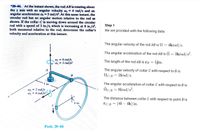
Elements Of Electromagnetics
7th Edition
ISBN: 9780190698614
Author: Sadiku, Matthew N. O.
Publisher: Oxford University Press
expand_more
expand_more
format_list_bulleted
Concept explainers
Question
Can someone explain to me the solution of this problem please and why VB=(-20i) rad/s? Why rC/B=(4i-4k)in?
![76.2
2:47 PM
"O.
A 29
K/s
USM-CEN
2-BSABE-B
Calculate the velocity of coll ar B.
VB = Oxr3
V3 = (4k)×(5j)
V3 =(-20i)in./s
LIT 111A:
Literature
I hilipp
Calculate the accelerati on of collar B.
a; = [4k×(-20i)]+[(3k)×(5j)]
%3D
a3 =(-15i – 80j)in./s?
Calculate the velocity of collar C relative to the collar B.
C/B
VCB =(-3k)+(2i)x(4i – 4k)
VCE = (8j- 3k)in./s
Calculate the accelerati on of collar Crelative to the collar B.
j-Sk +[(2i)×(-3k)]+[(8i)×(4i-4k)]
+[(21)×(8j- 3k)]
acB
acs-
j-8k +[(6i)]+[(32i)]+[(16k +6j]}
aCB =(-2.25i +44j + 8k)in./s?
Calculate the velocity of collar C.
Vc =V3+0xrcB+ VC/B
Vc =(-20i)+(4k)x(4i – 4k)+(8j– 3k)
Vc =(-20i)+(16j)+(8j – 3k)
Vc =(-20i +24j- 3k )in./s
Calculate the accel eration of collar C.
ac = a3 +(óxrc3)+ox(@xrc3)+(2oxv3)+acB
[(-15i – 80j) +[(3k)×(4i – 4k)]+(4k)x(4kx(4i- 4k)
ac
(+(2(4k)x(8i – 3k))+(-2.25i + 44j+8k)
|
(-15i -80j) + [(12)]+(4k)×(16j)]
ac
(+(64j) +(-2.25i+ 44j+8k)
ac = {(-15i – 80j)+[(12j)]+(-64i)+(64j)+(-2.25i + 44j + 8k
%3D
ac =(-145i- 24j+ 8k)in./s²](https://content.bartleby.com/qna-images/question/968374dc-5a0b-47ae-8564-d1a542c61509/e698823c-0e4c-490e-9ce4-ca4110cd0b41/rixlto_thumbnail.jpeg)
Transcribed Image Text:76.2
2:47 PM
"O.
A 29
K/s
USM-CEN
2-BSABE-B
Calculate the velocity of coll ar B.
VB = Oxr3
V3 = (4k)×(5j)
V3 =(-20i)in./s
LIT 111A:
Literature
I hilipp
Calculate the accelerati on of collar B.
a; = [4k×(-20i)]+[(3k)×(5j)]
%3D
a3 =(-15i – 80j)in./s?
Calculate the velocity of collar C relative to the collar B.
C/B
VCB =(-3k)+(2i)x(4i – 4k)
VCE = (8j- 3k)in./s
Calculate the accelerati on of collar Crelative to the collar B.
j-Sk +[(2i)×(-3k)]+[(8i)×(4i-4k)]
+[(21)×(8j- 3k)]
acB
acs-
j-8k +[(6i)]+[(32i)]+[(16k +6j]}
aCB =(-2.25i +44j + 8k)in./s?
Calculate the velocity of collar C.
Vc =V3+0xrcB+ VC/B
Vc =(-20i)+(4k)x(4i – 4k)+(8j– 3k)
Vc =(-20i)+(16j)+(8j – 3k)
Vc =(-20i +24j- 3k )in./s
Calculate the accel eration of collar C.
ac = a3 +(óxrc3)+ox(@xrc3)+(2oxv3)+acB
[(-15i – 80j) +[(3k)×(4i – 4k)]+(4k)x(4kx(4i- 4k)
ac
(+(2(4k)x(8i – 3k))+(-2.25i + 44j+8k)
|
(-15i -80j) + [(12)]+(4k)×(16j)]
ac
(+(64j) +(-2.25i+ 44j+8k)
ac = {(-15i – 80j)+[(12j)]+(-64i)+(64j)+(-2.25i + 44j + 8k
%3D
ac =(-145i- 24j+ 8k)in./s²

Transcribed Image Text:*20-44. At the instant shown, the rod AB is rotating about
the z axis with an angular velocity an = 4 rad/s and an
angular acceleration o =3 rad/s2. At this same instant, the
circular rod has an angular motion relative to the rod as
shown. If the collar C is moving down around the circular
rod with a speed of 3 in./s, which is increasing at 8 in./s,
both measured relative to the rod, determine the collar's
velocity and acceleration at this instant.
Step 1
We are provided with the following data:
The angular velocity of the rod AB is N = 4krad/s.
The angular acceleration of the rod AB is N = 3krad/s².
W1 = 4 rad/s
w = 3 rad/s2
The length of the rod AB is rB =
5jin.
A
The angular velocity of collar C with respect to B is
NC/B = 2irad/s.
В
5 in.
The angular acceleration of collar C with respect to B is
w2 = 2 rad/s
8 rad/s2
İC/B = 8irad/s?.
The distance between collar C with respect to point B is
4 in.
rc/в 3 (4i — 4k) in.
Prob. 20-44
Expert Solution
This question has been solved!
Explore an expertly crafted, step-by-step solution for a thorough understanding of key concepts.
Step by stepSolved in 2 steps with 2 images

Knowledge Booster
Learn more about
Need a deep-dive on the concept behind this application? Look no further. Learn more about this topic, mechanical-engineering and related others by exploring similar questions and additional content below.Similar questions
Recommended textbooks for you
 Elements Of ElectromagneticsMechanical EngineeringISBN:9780190698614Author:Sadiku, Matthew N. O.Publisher:Oxford University Press
Elements Of ElectromagneticsMechanical EngineeringISBN:9780190698614Author:Sadiku, Matthew N. O.Publisher:Oxford University Press Mechanics of Materials (10th Edition)Mechanical EngineeringISBN:9780134319650Author:Russell C. HibbelerPublisher:PEARSON
Mechanics of Materials (10th Edition)Mechanical EngineeringISBN:9780134319650Author:Russell C. HibbelerPublisher:PEARSON Thermodynamics: An Engineering ApproachMechanical EngineeringISBN:9781259822674Author:Yunus A. Cengel Dr., Michael A. BolesPublisher:McGraw-Hill Education
Thermodynamics: An Engineering ApproachMechanical EngineeringISBN:9781259822674Author:Yunus A. Cengel Dr., Michael A. BolesPublisher:McGraw-Hill Education Control Systems EngineeringMechanical EngineeringISBN:9781118170519Author:Norman S. NisePublisher:WILEY
Control Systems EngineeringMechanical EngineeringISBN:9781118170519Author:Norman S. NisePublisher:WILEY Mechanics of Materials (MindTap Course List)Mechanical EngineeringISBN:9781337093347Author:Barry J. Goodno, James M. GerePublisher:Cengage Learning
Mechanics of Materials (MindTap Course List)Mechanical EngineeringISBN:9781337093347Author:Barry J. Goodno, James M. GerePublisher:Cengage Learning Engineering Mechanics: StaticsMechanical EngineeringISBN:9781118807330Author:James L. Meriam, L. G. Kraige, J. N. BoltonPublisher:WILEY
Engineering Mechanics: StaticsMechanical EngineeringISBN:9781118807330Author:James L. Meriam, L. G. Kraige, J. N. BoltonPublisher:WILEY

Elements Of Electromagnetics
Mechanical Engineering
ISBN:9780190698614
Author:Sadiku, Matthew N. O.
Publisher:Oxford University Press

Mechanics of Materials (10th Edition)
Mechanical Engineering
ISBN:9780134319650
Author:Russell C. Hibbeler
Publisher:PEARSON

Thermodynamics: An Engineering Approach
Mechanical Engineering
ISBN:9781259822674
Author:Yunus A. Cengel Dr., Michael A. Boles
Publisher:McGraw-Hill Education

Control Systems Engineering
Mechanical Engineering
ISBN:9781118170519
Author:Norman S. Nise
Publisher:WILEY

Mechanics of Materials (MindTap Course List)
Mechanical Engineering
ISBN:9781337093347
Author:Barry J. Goodno, James M. Gere
Publisher:Cengage Learning

Engineering Mechanics: Statics
Mechanical Engineering
ISBN:9781118807330
Author:James L. Meriam, L. G. Kraige, J. N. Bolton
Publisher:WILEY